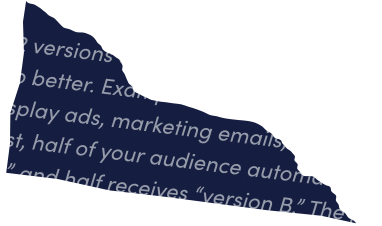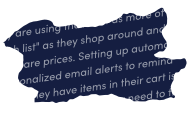Click-through rate (CTR) is a marketing metric that denotes how many times a digital ad was clicked by the viewing audience, in relation to the number of impressions of the ad that were served. A high CTR is desirable, as it means that the ad is interesting or relevant enough to the viewer to entice them to click and continue the interaction with the brand.
What is CTR?
Click-through rate, or CTR, is a percentage figure demonstrating the ratio of people who click on a digital ad, compared to the number of impressions of the ad served, in a given campaign or time period. CTR is a common and popular digital marketing metric that allows companies to understand how well their ads are being received by the target audience. CTR is also a measure of how much traffic an ad is driving to the advertiser’s website or online store. Average CTRs vary among industries and where your customers are in the sales funnel. Companies may compare their CTRs with industry averages or with their internal KPIs to see if improvements are needed.
Why is CTR important?
Click-through rate is a clear indicator of whether an online ad is generating interest among the target audience, and how much traffic the ad is driving to the advertiser’s website. High CTRs lead to increased website traffic. By improving CTR, you can get more visitors to your site.
CTR is a good metric for top-of-funnel campaigns, or brand awareness campaigns, as it indicates whether an ad is engaging, and whether the audience is interacting with it. It is less useful for campaigns with conversion-based KPIs, such as purchases or app installs.
If the CTR is low compared to the industry average, it signals that the marketing team should change the ad content or design, or adjust the targeting strategy, or improve some other aspect of the campaign.
How to measure CTR
Measuring CTR is easy. The metric records the number of times your ad or link is clicked divided by how many times it was shown. For example, if your ad was shown 100 times and three people clicked on it, your CTR would be 0.03%.
(Times clicked) / (Times shown) = Click-through rate
What is a good CTR?
A good click-through rate is difficult to define, as there are several factors at play, such as the industry or niche, where the customers are in the sales funnel, and the platform or device where the ads are shown.
WordStream’s recent study shows that a good CTR varies significantly based on the company’s industry. The study looked at North American accounts between May 2020 to June 2021. It’s also worth noting that CTRs are typically higher for brand name searches versus generic searches. Here are some examples of benchmark CTRs by industry:
- Arts & Entertainment: 16.29%
- Automotive: 8.15%
- Beauty: 6.16%
- Fashion & Jewelry: 2.24%
- Finance & Insurance: 8.88%
- Health & Fitness: 6.39%
- Home & Home Improvement: 3.95%
- Restaurant & Food: 8.37%
- Shopping (General): 2.45%
- Sports & Recreation: 11.69%
- Travel: 10.29%
CTR vs Conversion rate (CVR)
Your click-through rate is a percentage showing how many people clicked on your ad divided by the total number of people who saw it. However, a high CTR on its own does not necessarily translate to increased conversions, sales, or revenue. That’s why companies monitor multiple marketing metrics, including conversion rate (CVR).
Conversion rate is a percentage demonstrating how many people completed an action on a website or app divided by the total number of visitors. A high CTR indicates that a large portion of people viewing an ad clicks through to the website, but they might not complete a transaction or convert once there.
If an ad is misleading, or if the landing page is unclear or unattractive, many people may click through to the website yet leave before taking any other action or converting. A campaign with a high CTR yet low CVR may need to be reworked.
What is CTR in email marketing?
Email marketing is slightly different from paid advertisements on websites and search engines. To determine the CTR for email marketing, divide the total number of clicks on any link in the email by the total number of emails sent.
CTR vs CTOR
In email marketing, click-through rate measures the number of people who click through any link in an email, compared to the total number of emails sent out. The click-to-open rate (CTOR), however, is slightly different. CTOR measures the number of people who click on a link in an email, divided only by the total number of opened emails.
If your emails have high CTOR, that means that a good proportion of the recipients who open the emails are enticed to click through to your website via a link that appears in the email. This indicates that the content in your email is working well.
If you have a low CTOR rate, the marketing team may need to redesign the email layout or rework the copy to make it more engaging and persuasive.
How to improve CTR
If your marketing team has noticed that your ads aren’t performing as well as you’d hoped, don’t despair. Improving your CTR may seem challenging, but there are a few universal tips to attract more attention from your target audience.
- Use video or other attention-grabbing elements: Banner blindness is a real problem and has a huge impact on CTR. Engage the target audience by using video or other interactive elements in your ad to pique their interest and encourage them to click.
- Craft great calls-to-action: Your copy is designed to capture people’s attention, provide relevant information about a problem they have and how your company can solve it, and then compel the user to complete an action. In this case, the action is to click on a link to your website. You’ll want a well-crafted call-to-action to light a fire under the readers so they’ll click through instead of putting it off and possibly forgetting about it.
- Perform keyword research for long-tailed keywords: Long-tailed keywords are multi-word search phrases or questions that are much more specific than general keywords. By putting descriptive long-tailed keywords in your headers and tags, you can attract a more focused audience that is specifically looking for the type of services or products that your company provides. Then they’ll be more likely to click through to your website.
- Write specific meta descriptions: When your website appears on a search engine results page, users typically see a heading and a snippet of text. That text, or meta description, can be the deciding factor of whether or not they click through to your website, so you want it to be as informative and enticing as possible. Use your meta description to answer questions or solve problems that potential customers have.
- Try localized content: More people than ever are searching on mobile, and most devices have location turned on. Take advantage of that location data by providing localized content. If you are a local business, or if you operate in specific areas, use your location as one of your keywords to increase your CTR.
- Lower page load time: In some cases, the ad copy isn’t the problem; it’s your website. If a page takes too long to load, many users will simply bounce after clicking on your link. Even a few seconds of additional load time can significantly impact your CTR, so be sure to keep an eye on it and make improvements to reduce page load time whenever necessary.


